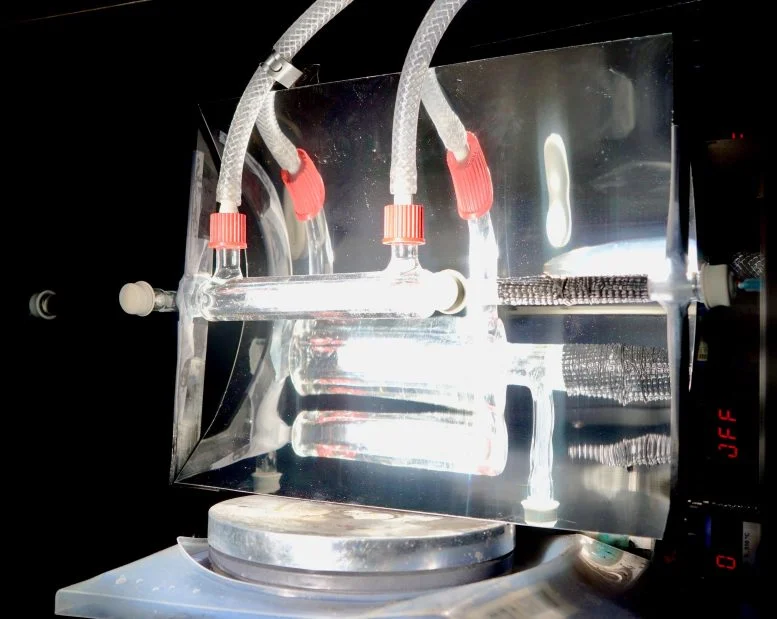Researchers have unveiled a groundbreaking reactor that harnesses sunlight to capture carbon dioxide from the atmosphere and convert it into sustainable fuel.
In contrast to conventional carbon capture techniques, this innovative device operates entirely without fossil fuels, positioning it as a revolutionary solution to the climate crisis. By mimicking the process of photosynthesis, the reactor generates syngas, a vital component in fuels and pharmaceuticals, with plans for scaling up to produce liquid fuels.
Utilizing Sunlight for Sustainable Energy
Scientists at the University of Cambridge have developed a solar-powered reactor that directly captures atmospheric CO2 and transforms it into sustainable fuel using sunlight.
This state-of-the-art reactor has the potential to produce fuel for transportation, as well as key chemicals and pharmaceuticals. Additionally, it could serve as a reliable energy source in remote or off-grid areas.
Unlike traditional carbon capture technologies, which depend on fossil fuel energy and require the transport and storage of CO2, this reactor streamlines the process by directly converting atmospheric carbon into valuable products using solely solar energy. The research findings were published in Nature Energy on February 13.
The Drawbacks of Conventional Carbon Storage
Carbon Capture and Storage (CCS) has been touted as a viable solution for the climate crisis, receiving approximately £22 billion ($27 billion) in funding from the UK government. However, it is highly energy-intensive and raises concerns about the long-term safety of storing pressurized CO2 underground, with ongoing studies examining these risks.
“Besides the high costs and energy demands, CCS allows for the continued burning of fossil fuels, which is at the root of the climate crisis,” stated Professor Erwin Reisner, who led the research. “Moreover, CCS is a non-circular process; the pressurized CO2 is stored underground indefinitely, where it serves no practical purpose.”
Transforming a Harmful Gas into Valuable Chemicals
“What if we could convert carbon dioxide into something beneficial instead of burying it?” asked Dr. Sayan Kar, the study’s lead author from Cambridge’s Yusuf Hamied Department of Chemistry. “While CO2 is a harmful greenhouse gas, it can be transformed into useful chemicals without contributing to global warming.”
Reisner’s research group focuses on developing devices that convert waste, water, and air into practical fuels and chemicals, drawing inspiration from photosynthesis—the process by which plants transform sunlight into energy. These devices require no external power, relying solely on sunlight.
From Air to Syngas: A Major Breakthrough
The team’s latest system captures CO2 directly from the atmosphere and converts it into syngas, a critical intermediate for various chemicals and pharmaceuticals. They assert that their approach, which eliminates the need for transportation or storage, is significantly easier to scale than previous solar-powered devices.
The solar-powered flow reactor utilizes specialized filters to capture CO2 from the air at night, similar to how a sponge absorbs water. When exposed to sunlight, the captured CO2 is heated, absorbing infrared radiation, while a semiconductor powder absorbs ultraviolet radiation to initiate a chemical reaction that converts CO2 into solar syngas. A mirror on the reactor further concentrates the sunlight, enhancing efficiency.
Towards Liquid Fuels and Scalable Solutions
The researchers are currently working on converting solar syngas into liquid fuels that could power vehicles and aircraft, all while avoiding additional CO2 emissions.
“If we produce these devices at scale, we could address two challenges simultaneously: removing CO2 from the atmosphere and creating a clean alternative to fossil fuels,” Kar noted. “CO2 is often viewed as waste, but it presents an opportunity.”
Envisioning a Future Without Fossil Fuels
The researchers highlight a particularly promising avenue in the chemical and pharmaceutical sectors, where syngas can be transformed into everyday products without exacerbating climate change. They are developing a larger-scale version of the reactor and anticipate testing it in the spring.
If successfully scaled, their reactor could function in a decentralized manner, allowing individuals to potentially generate their own fuel, which would be beneficial for remote or off-grid areas.
“Rather than continuing to extract and burn fossil fuels for essential products, we can capture CO2 directly from the air and repurpose it,” Reisner concluded. “This could pave the way for a circular, sustainable economy—provided there is the political will to make it happen.”
Reference: “Direct Air Capture of CO2 for Solar Fuel Production in Flow” by Sayan Kar, Dongseok Kim, Ariffin Bin Mohamad Annuar, Bidyut Bikash Sarma, Michael Stanton, Erwin Lam, Subhajit Bhattacharjee, Suvendu Karak, Heather F. Greer, and Erwin Reisner, February 13, 2025, Nature Energy.
The technology is being commercialized with the backing of Cambridge Enterprise, the University’s commercialization arm. The research received support from UK Research and Innovation (UKRI), the European Research Council, the Royal Academy of Engineering, and the Cambridge Trust. Erwin Reisner is a Fellow of St John’s College, Cambridge.





